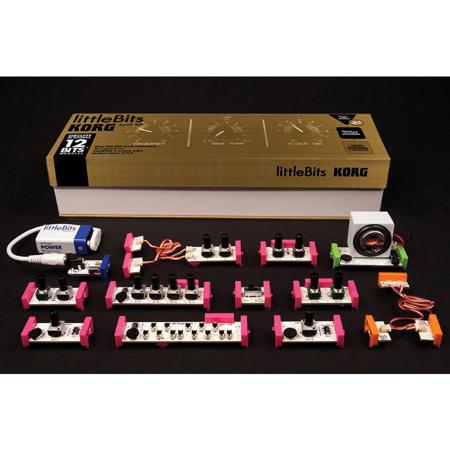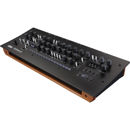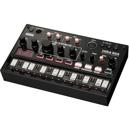
Korg littleBits Synth Kit, Includes Power Module, 2x Oscillator, Random, Keyboard, Micro Sequencer, Envelope, Filter, Delay, Mix, Split, Speaker
SKU: KOSYNTHKIT
This item is no longer available.
Recommended Alternatives
Share:
Overview
Compare
Q&A
Questions & Answers
Reviews about this item
Review Summary
About Korg Synth Kit
Unleash Your Inner Rochstar
littleBits and Korg have demystified a traditional analog synthesizer, making it super easy for novices and experts alike to create music.
• connects to speakers, computers and headphones
• can be used to make your own instruments
• fits into the littleBits modular system for infinite combos of audio, visual and sensory experiences
Power
This power module lets you use a 9 volt battery to supply electricity to your littleBits. Snap in the battery + cable (not included) and flip the switch to turn it on. To make the simplest littleBits circuit, connect the power Bit to an LED bit and start shining!
Oscillator
The oscillator is the main sound source in the Synth Kit and is capable of creating audio tones that will be used in almost every sound experiment you create. It features a "pitch" knob to adjust its output tone and a "tune" dial for adjusting the tuning when using with the keyboard. It also features a mode switch that'selects between "square" and "saw" waveforms. The "square" waveform has a rich, powerful character and the "saw" waveform has a more mellow, rounder character. [You'll often use it after the Keyboard or Micro Sequencer Bits modules, but you can have lots of fun by just twisting the pitch knob and "sweeping" through all the frequencies from high to low pitches.]
Random
The littleBits random module has two modes: "noise" and "random voltage". In "noise" mode, it outputs white noise, like a television set not tuned to any channel. In "random voltage" mode, it outputs random voltage signals that can control oscillators and make them play random pitches. Use the "trigger out" connector and "speed" dial of the micro sequencer to set the timing of the random output pulses and use an input Bits module like a dimmer to control the range of your random outputs.
Keyboard
The keyboard lets you play melodies- it features 13 switches that make up an entire octave of notes. It has two modes: "press" (which only produces output when you press a switch) and "hold" (which will hold the last note you played). It also features an octave control which changes the playable range. In addition to its main output, which is great for controlling their oscillators, it also has a "trigger out", which you can send to the "trigger in" of envelope or other littleBits modules.
Micro Sequencer
The micro sequencer sends out voltages based on the position of each of the four "step" knobs. Connect it to an oscillator and it will step through the "sequence" consecutively to make a melody (The LEDs tell you which step is active). Turn a knob all the way counter-clockwise to make the step silent. Use it in "speed" mode to set the speed using the dial or flip the switch to "step" mode to use an input module like a pulse or button for control. In addition to its main output, it also has a trigger output, which you can send to any of your other Bits modules.
Envelope
The envelope modifies the loudness contour of a sound. It takes a sound input and shapes it into something you'd hear from an acoustic musical instrument, like a piano or saxophone. This envelope has two controls: "attack", which is how long it takes to ramp up to maximum volume and "decay", which is how long it takes to go down to silence again. You can use its third bitSnap to trigger the envelope from different sources, like the keyboard. [Try it putting the envelope after an oscillator being controlled by a micro sequencer.]
Filter
The filter has the most effect on the sound's character or "timbre". It affects the timbre by changing the relative volume of certain frequencies in the sound. Use it to give the impression that a sound is "brighter" (more high frequencies) or "darker" (more low frequencies.) The "cutoff" knob sets the frequency to be emphasized and the other controls 'peak,' or intensity of the filter. If the peak is turned up all the way, the filter turns into an oscillator! [This is great for shaping all of the sounds you can make with the Synth Kit, but it's especially good with a noise input.]
Delay
The littleBits delay module takes incoming audio and repeats it, like an echo. It has two knobs: "time", which sets the delay length between a sound and its repetition and "feedback", which controls how many times the sound repeats. Delays can be long and spacey, like shouting into the Grand Canyon or loud and crazy. This Bits module will play forever if you turn up the Feedback knob all the way. [You can also shift the pitch of a sound by turning the "time" control while a sound is repeating.]
Mix
The littleBits mix module allows you to combine two inputs and send them to a single output. It also has a volume control for each of its inputs -- that's where the 'mixing' comes in. Use it to play two oscillators on a single speaker!
Split
The littleBits split module sends a single input to two wired outputs. It's great for connecting one output to two inputs, like using a keyboard to control two oscillators. But keep in mind that it can be used just like a wire module if you ignore one of its outputs.
Synth Speaker
The synth speaker amplifies your sonic explorations! You can control the volume with a dial at the front of the module. It also features an output jack that you can connect to headphones, an amplifier or a computer. The speaker is connected with 3M Dual Lock so it can be removed from the circuit board. To reattach, simply press together firmly.
What's in the box:
- Korg Power Module
- 2x Oscillators
- Random
- Keyboard
- Micro Sequencer
- Envelope
- Filter
- Delay
- Mix
- Split
- Synth Speaker
- Korg littleBits 1 Year Parts & Labor Warranty

